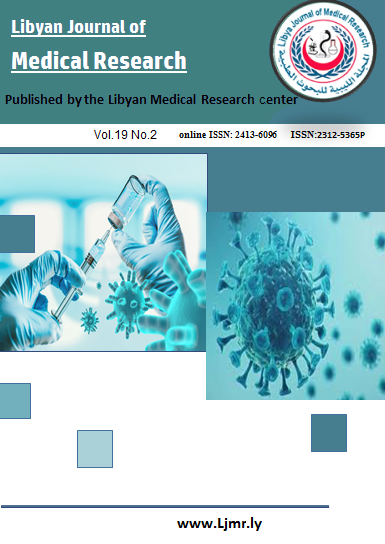The Role of Noninvasive Ventilation in Managing Respiratory Failure: A Literature Review
DOI:
https://doi.org/10.54361/LJMR.19.2.17Keywords:
Respiratory Failure, Non-invasive Ventilation (NIV), Principles, Mechanisms, Types, Efficacy, Benefits, Clinical Outcomes, Indications, Contraindications, Technical Aspects & InnovationsAbstract
Background: Respiratory failure is a serious condition characterized by the inability of the respiratory system to maintain adequate gas exchange, resulting in hypoxemia, hypercapnia, or both. Non-invasive ventilation (NIV) has emerged as an essential tool in the management of acute and chronic respiratory failure. It offers significant advantages, such as reduced need for endotracheal intubation, fewer ventilation-related complications, improved patient comfort, and reduced hospital stay. NIV is now widely used in intensive care units, emergency departments, and at home. Objectives: This comprehensive review aims to explore the principles, mechanisms, and types of non-invasive ventilation and focuses on providing a detailed comparison with invasive mechanical ventilation. In addition, it addresses the clinical efficacy, benefits, and outcomes of NIV, its indications and contraindications, current recommendations, technical considerations, and recent advances, including emerging technologies and innovations. This review also addresses the challenges and limitations encountered during the implementation of NIV and offers recommendations for clinical practice and future research. Conclusion: NIV is essential for the treatment of respiratory failure, particularly in conditions such as COPD exacerbations, cardiogenic pulmonary edema, and certain cases of hypoxemia. It also improves quality of life and survival in chronic diseases such as neuromuscular disorders and obesity-hypoventilation syndrome. Achieving optimal outcomes depends on appropriate patient selection, interface selection, ventilator settings, and competent monitoring. Future directions include personalized NIV strategies, AI-based systems, expanded access to low-resource settings, and more clinical trials to refine its role in conditions such as pneumonia and ARDS.
Downloads
References
1. Inal, V., & Efe, S. (2021). Extracorporeal carbon dioxide removal (ECCO2R) in COPD and ARDS patients withsevere hypercapnic respiratory failure. A retrospective case-control study. Turkish Journal of Medical Sciences, 51(4), 2127-2134.
2. Sharma, R., & Wolfe, L. (2017). Use of non-invasive ventilation in neuromuscular disease. Current Sleep Medicine Reports, 3(4), 290-298.
3. Mas, A., & Masip, J. (2014). Noninvasive ventilation in acute respiratory failure. International journal of chronic obstructive pulmonary disease, 837-852.
4. Hess, D. R. (2011). Patient-ventilator interaction during noninvasive ventilation. Respiratory Care, 56(2), 153-167.
5. Soo Hoo, G. W. (2020). Multidisciplinary Approach to Noninvasive Ventilation (NIV) in Critical Care. In Noninvasive Ventilation in Sleep Medicine and Pulmonary Critical Care: Critical Analysis of 2018-19 Clinical Trials (pp. 443-454). Cham: Springer International Publishing.
6. Ergan, B., Oczkowski, S., Rochwerg, B., Carlucci, A., Chatwin, M., Clini, E., ... & Windisch, W. (2019). European Respiratory Society guidelines on long-term home non-invasive ventilation for management of COPD. European respiratory journal, 54(3).
7. Patil, S. P., Ayappa, I. A., Caples, S. M., Kimoff, R. J., Patel, S. R., & Harrod, C. G. (2019). Treatment of adult obstructive sleep apnea with positive airway pressure: an American Academy of Sleep Medicine clinical practice guideline. Journal of Clinical Sleep Medicine, 15(2), 335-343.
8. Johnson, K. G. (2022). APAP, BPAP, CPAP, and new modes of positive airway pressure therapy. Advances in the Diagnosis and Treatment of Sleep Apnea: Filling the Gap Between Physicians and Engineers, 297-330.
9. Ameen, A., Zedan, M., & El Shamly, M. (2012). Comparison between continuous positive airway pressure and bilevel positive pressure ventilation in treatment of acute exacerbation of chronic obstructive pulmonary disease. Egyptian Journal of Chest Diseases and Tuberculosis, 61(3), 95-101.
10. Faqihi, B. M., Trethewey, S. P., Morlet, J., Parekh, D., & Turner, A. M. (2021). Bilevel positive airway pressure ventilation for non-COPD acute hypercapnic respiratory failure patients: a systematic review and meta-analysis. Annals of thoracic medicine, 16(4), 306-322.
11. Duiverman, M. L., Vonk, J. M., Bladder, G., van Melle, J. P., Nieuwenhuis, J., Hazenberg, A., ... & Wijkstra, P. J. (2020). Home initiation of chronic non-invasive ventilation in COPD patients with chronic hypercapnic respiratory failure: a randomised controlled trial. Thorax, 75(3), 244-252.
12. Amaddeo, A., Frapin, A., & Fauroux, B. (2016). Long-term non-invasive ventilation in children. The Lancet Respiratory Medicine, 4(12), 999-1008.
13. Tusman, G., & Böhm, S. H. (2010). Prevention and reversal of lung collapse during the intra-operative period. Best Practice & Research Clinical Anaesthesiology, 24(2), 183-197.
14. Rowland, S., Aiyappan, V., Hennessy, C., Catcheside, P., Chai-Coezter, C. L., McEvoy, R. D., & Antic, N. A. (2018). Comparing the efficacy, mask leak, patient adherence, and patient preference of three different CPAP interfaces to treat moderate-severe obstructive sleep apnea. Journal of clinical sleep medicine, 14(1), 101-108.
15. Briones Claudett, K. H., Briones Claudett, M., Chung Sang Wong, M., Nuques Martinez, A., Soto Espinoza, R., Montalvo, M., ... & Grunauer Andrade, M. (2013). Noninvasive mechanical ventilation with average volume assured pressure support (AVAPS) in patients with chronic obstructive pulmonary disease and hypercapnic encephalopathy. BMC pulmonary medicine, 13(1), 12.
16. Forrest, I. S., Jaladanki, S. K., Paranjpe, I., Glicksberg, B. S., Nadkarni, G. N., & Do, R. (2021). Non-invasive ventilation versus mechanical ventilation in hypoxemic patients with COVID-19. Infection, 49(5), 989-997.
17. Hongisto, M., Lassus, J., Tarvasmaki, T., Sionis, A., Tolppanen, H., Lindholm, M. G., ... & Harjola, V. P. (2017). Use of noninvasive and invasive mechanical ventilation in cardiogenic shock: A prospective multicenter study. International journal of cardiology, 230, 191-197.
18. Bello, G., De Pascale, G., & Antonelli, M. (2016). Noninvasive ventilation. Clinics in chest medicine, 37(4), 711-721.
19. Liao, H., Pei, W., Li, H., Luo, Y., Wang, K., Li, R., ... & Chen, X. (2017). Efficacy of long-term noninvasive positive pressure ventilation in stable hypercapnic COPD patients with respiratory failure: a meta-analysis of randomized controlled trials. International journal of chronic obstructive pulmonary disease, 2977-2985.
20. Fisher, K. A., Mazor, K. M., Goff, S., Stefan, M. S., Pekow, P. S., Williams, L. A., ... & Lindenauer, P. K. (2017). Successful use of noninvasive ventilation in chronic obstructive pulmonary disease. How do high-performing hospitals do it?. Annals of the American Thoracic Society, 14(11), 1674-1681.
21. Osadnik, C. R., Tee, V. S., Carson‐Chahhoud, K. V., Picot, J., Wedzicha, J. A., & Smith, B. J. (2017). Non‐invasive ventilation for the management of acute hypercapnic respiratory failure due to exacerbation of chronic obstructive pulmonary disease. Cochrane database of systematic reviews, (7).
22. Bello, G., De Santis, P., & Antonelli, M. (2018). Non-invasive ventilation in cardiogenic pulmonary edema. Annals of translational medicine, 6(18), 355.
23. Del Sorbo, L., Jerath, A., Dres, M., & Parotto, M. (2016). Non-invasive ventilation in immunocompromised patients with acute hypoxemic respiratory failure. Journal of thoracic disease, 8(3), E208.
24. Yeung, J., Couper, K., Ryan, E. G., Gates, S., Hart, N., & Perkins, G. D. (2018). Non-invasive ventilation as a strategy for weaning from invasive mechanical ventilation: a systematic review and Bayesian meta-analysis. Intensive care medicine, 44(12), 2192-2204.
25. Mandal, S., Suh, E. S., Harding, R., Vaughan-France, A., Ramsay, M., Connolly, B., ... & Hart, N. (2018). Nutrition and Exercise Rehabilitation in Obesity hypoventilation syndrome (NERO): a pilot randomised controlled trial. Thorax, 73(1), 62-69.
26. Hyzy, R. C., & McSparron, J. I. (2023). Noninvasive ventilation in adults with acute respiratory failure: Benefits and contraindications. Editor: Polly E Parsons.
27. Masip, J., Peacock, W. F., Price, S., Cullen, L., Martin-Sanchez, F. J., Seferovic, P., ... & Acute Heart Failure Study Group of the Acute Cardiovascular Care Association and the Committee on Acute Heart Failure of the Heart Failure Association of the European Society of Cardiology. (2018). Indications and practical approach to non-invasive ventilation in acute heart failure. European heart journal, 39(1), 17-25.
28. Navarra, S. M., Congedo, M. T., & Pennisi, M. A. (2020). Indications for non-invasive ventilation in respiratory failure. Reviews on recent clinical trials, 15(4), 251-257.
29. Longhini, F., Bruni, A., Garofalo, E., Tutino, S., Vetrugno, L., Navalesi, P., ... & Cammarota, G. (2023). Monitoring the patient–ventilator asynchrony during non-invasive ventilation. Frontiers in Medicine, 9, 1119924.
30. Rochwerg, B., Brochard, L., Elliott, M. W., Hess, D., Hill, N. S., Nava, S., ... & Raoof, S. (2017). Official ERS/ATS clinical practice guidelines: noninvasive ventilation for acute respiratory failure. European Respiratory Journal, 50(2).
31. Carrillo, A., Ferrer, M., Gonzalez-Diaz, G., Lopez-Martinez, A., Llamas, N., Alcazar, M., ... & Torres, A. (2012). Noninvasive ventilation in acute hypercapnic respiratory failure caused by obesity hypoventilation syndrome and chronic obstructive pulmonary disease. American journal of respiratory and critical care medicine, 186(12), 1279-1285.
32. Roberts, M. (2017). Daytime predictors of sleep disordered breathing in Duchenne muscular dystrophy.
33. Ibrahim, M. Spontaneous versus spontaneous timed mode of assisted ventilation in extrathoracic restrictive lung.
34. Scala, R., Accurso, G., Ippolito, M., Cortegiani, A., Iozzo, P., Vitale, F., ... & Gregoretti, C. (2020). Material and technology: back to the future for the choice of interface for non-invasive ventilation–a concise review. Respiration, 99(9), 800-817.
35. Aydin, K., & Ozcengiz, D. (2020). NIV Modes and Settings. In Noninvasive Ventilation in Sleep Medicine and Pulmonary Critical Care: Critical Analysis of 2018-19 Clinical Trials (pp. 285-299). Cham: Springer International Publishing.
36. Soleimani, F., Donker, D. W., Oppersma, E., & Duiverman, M. L. (2024). Clinical evidence and technical aspects of innovative technology and monitoring of chronic NIV in COPD: a narrative review. Expert review of respiratory medicine, 18(7), 513-526.
37. Fernandez-Gonzalez, S. M., Sucasas Alonso, A., Ogando Martinez, A., & Avila-Alvarez, A. (2022). Incidence, predictors and outcomes of noninvasive ventilation failure in very preterm infants. Children, 9(3), 426.
38. Yalçınkaya, E., Eryüksel, E., Karakurt, S., Arıkan, H., Olgun, S., & Kasapoğlu, U. S. (2025). Challenges in Non-Invasive Ventilation: Understanding the Causes of NIV Failure and Complications. Osmangazi Tıp Dergisi, 47(1), 32-38.
39. Steindal, S. A., Hofsø, K., Aagaard, H., Mariussen, K. L., Andresen, B., Christensen, V. L., ... & Larsen, M. H. (2024). Non-invasive ventilation in the care of patients with chronic obstructive pulmonary disease with palliative care needs: A scoping review. BMC Palliative Care, 23(1), 27.
Downloads
Published
Issue
Section
License
Copyright (c) 2025 Rihab Abdlsalam Alweshahi, Mohamed A. Ali Elwafi, Abofila MTM, Abofila MTM, Azab Elsayed Azab, Khaled Abdulmola, Mouni AAA (Author)

This work is licensed under a Creative Commons Attribution-NonCommercial-NoDerivatives 4.0 International License.
Open Access Policy
Libyan journal of medical Research (LJMR).is an open journal, therefore there are no fees required for downloading any publication from the journal website by authors, readers, and institution.
The journal applies the license of CC BY (a Creative Commons Attribution 4.0 International license). This license allows authors to keep ownership f the copyright of their papers. But this license permits any user to download , print out, extract, reuse, archive, and distribute the article, so long as appropriate credit is given to the authors and the source of the work.
The license ensures that the article will be available as widely as possible and that the article can be included in any scientific archive.
Editorial Policy
The publication of an article in a peer reviewed journal is an essential model for Libyan journal of medical Research (LJMR). It is necessary to agree upon standards of expected ethical behavior for all parties involved in the act of publishing: the author, the journal editorial, the peer reviewer and the publisher.
Any manuscript or substantial parts of it, submitted to the journal must not be under consideration by any other journal. In general, the manuscript should not have already been published in any journal or other citable form, although it may have been deposited on a preprint server. Authors are required to ensure that no material submitted as part of a manuscript infringes existing copyrights, or the rights of a third party.
Authorship Policy
The manuscript authorship should be limited to those who have made a significant contribution and intellectual input to the research submitted to the journal, including design, performance, interpretation of the reported study, and writing the manuscript. All those who have made significant contributions should be listed as co-authors.
Others who have participated in certain substantive aspects of the manuscript but without intellectual input should only be recognized in the acknowledgements section of the manuscript. Also, one of the authors should be selected as the corresponding author to communicate with the journal and approve the final version of the manuscript for publication in the LJMR.
Peer-review Policy
- All the manuscripts submitted to LJMR will be subjected to the double-blinded peer-review process;
- The manuscript will be reviewed by two suitable experts in the respective subject area.
- Reports of all the reviewers will be considered while deciding on acceptance/revision or rejection of a manuscript.
- Editor-In-Chief will make the final decision, based on the reviewer’s comments.
- Editor-In-Chief can ask one or more advisory board members for their suggestions upon a manuscript, before making the final decision.
- Associate editor and review editors provide administrative support to maintain the integrity of the peer-review process.
- In case, authors challenge the editor’s negative decision with suitable arguments, the manuscript can be sent to one more reviewer and the final decision will be made based upon his recommendations.












